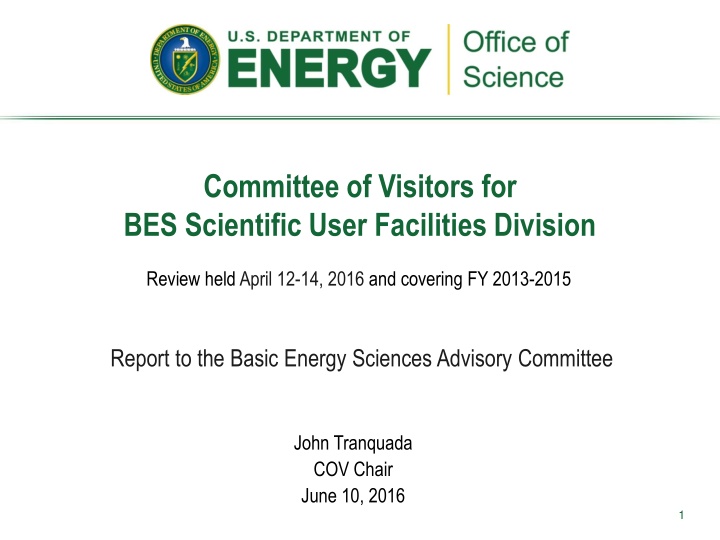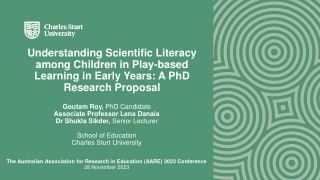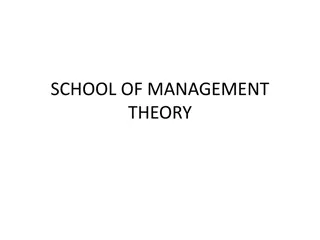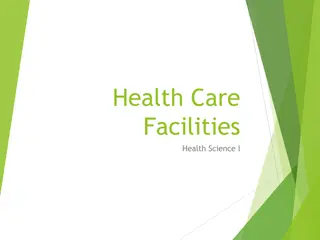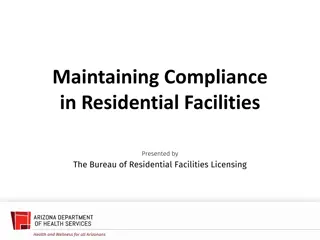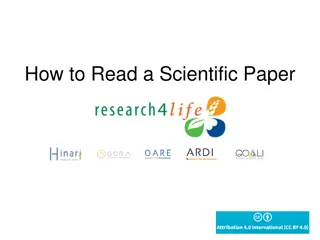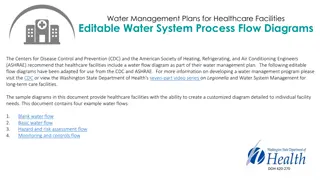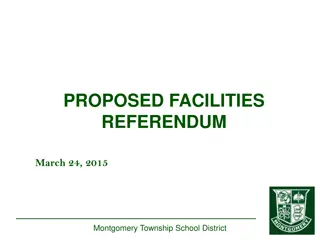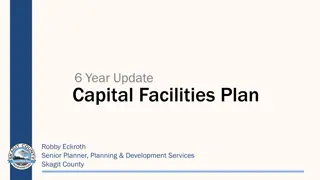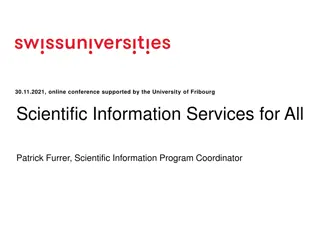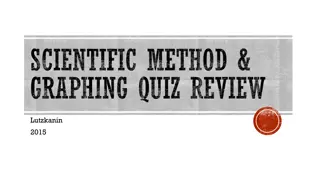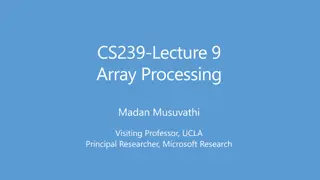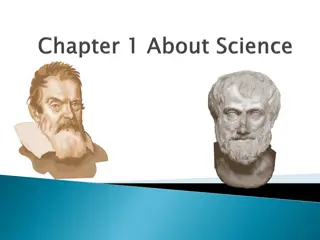Effective Management of Scientific User Facilities Review
The report covers the Committee of Visitors' review of the Basic Energy Sciences Scientific User Facilities Division from FY 2013-2015, highlighting assessments on proposal actions, active projects, award processes, and impact on national and international standing. Key areas evaluated include X-ray and Neutron facilities, Nano-Science Centers, and more.
Download Presentation

Please find below an Image/Link to download the presentation.
The content on the website is provided AS IS for your information and personal use only. It may not be sold, licensed, or shared on other websites without obtaining consent from the author.If you encounter any issues during the download, it is possible that the publisher has removed the file from their server.
You are allowed to download the files provided on this website for personal or commercial use, subject to the condition that they are used lawfully. All files are the property of their respective owners.
The content on the website is provided AS IS for your information and personal use only. It may not be sold, licensed, or shared on other websites without obtaining consent from the author.
E N D
Presentation Transcript
Committee of Visitors for BES Scientific User Facilities Division Review held April 12-14, 2016 and covering FY 2013-2015 Report to the Basic Energy Sciences Advisory Committee John Tranquada COV Chair June 10, 2016 1
Charge from John Hemminger, BESAC Chair 1. For the scientific user facilities including the accelerator and detector program, assess the efficacy and quality of the processes used to: (a) solicit, review, recommend, and document proposal actions and (b) monitor active projects and programs. 2. Within the boundaries defined by DOE missions and available funding, comment on how the award process has affected: (a) the breadth and depth of portfolio elements, and (b) the national and international standing of the portfolio elements.
BES SUFD Committee of Visitors Dr. John Tranquada (BNL), Chair Construction Projects Angus Bampton (PNNL) Jim Krupnick (retired) John Post (LLNL) Light Sources, Accelerator & Detector R&D Prof. Angus Wilkinson (Georgia Tech) Prof. Nora Berrah (UConn) Prof. Philippe Piot (NIU) Prof. Oleg Shpyrko (UCSD) Dr. Vyshnavi Suntharalingam (MIT LL) Nano-Science Centers Prof. Gary Rubloff (UMD) Prof. Jian-Min Zou (UIUC) Prof. Donald Tennant (Cornell) Dr. Celia Merzbacher (SRC) Neutron Scattering Facilities Dr. Robert Dimeo (NIST) Dr. Suzanne te Velthuis (ANL) Prof. Despina Louca (UVa) Prof. Norm Wagner (UDel) Chair Person in Red BESAC Member in Italics 3
Scope: Operating facilities, FY2013-FY2015 Six X-ray Light Sources, including the NSLS, which was closed at the end of FY14, and the NSLS-II, which began operations in FY15 Three Neutron Scattering Facilities, including the Lujan Center at Los Alamos, which was closed in FY14 Five Nanoscale Science Research Centers (NSRCs) Three Electron-Beam Microcharacterization Centers (EBMCs), which were administratively merged with the NSRCs in FY15 4
Scope: Line Item Construction and Major Items of Equipment Ongoing Projects: LCLS-II, APS-U, NEXT Completed Projects: NSLS-II, SING-II Terminated Projects: NGLS, PUP, TEAM-II On Hold Projects: STS 5
Main Conclusions SUFD is commended for effective use of its available funding for constructing and operating a set of facilities that deliver world-leading science The efficacy of the processes to review, recommend and document proposal actions is excellent The efficacy of the processes to monitor and review active projects, programs and facilities is also excellent 6
Main Conclusions (contd) SUFD staff are to be commended for rigorous and pragmatic program management in a highly constrained budget environment Within the scope of DOE missions and available funding, the award processes continue to enhance the breadth and depth of portfolio elements as well as their national and international standing International competition in scientific user facilities is stiff; maintaining U.S. scientific leadership will require increasing investments in facilities and user support 7
Collective Findings Implementation of previous COV findings SUFD responses were appropriate COV process effectiveness Well-organized files provided on individual laptops Staff members available and cooperative in answering questions 8
Collective Findings (contd) Facility review process The 3-year reviews of the facilities are well organized and well executed. The facility review teams are carefully selected for subject matter competence and absence of conflict of interest. In response to SUFD guidance, each facility has developed a strategic plan with articulated and measurable goals. Each facility has undergone a separate budget review. In the future, SUFD intends to include a budget review as part of each triennial facility review. Review results and BES guidance have sometimes been sent 9 to 12 months after the relevant review. 9
Collective Findings (contd) Breadth and quality of the portfolio elements COMMENT: SUFD did an excellent job partnering with BESAC to evaluate the international competition in light sources, resulting in a revised plan for facility upgrades that is essential for ensuring world- leading capabilities into the future General Issues Travel funds for program managers not commensurate with the needs for effective project oversight and community engagement. The fraction of facility users who are from industry has been gradually decreasing over the last three decades. Positive impact of BES facility investments on the US economy is of interest to the Office of Science. Each facility maintains information on use by industrial scientists, though this info has not been collected in one place. 10
Collective Recommendations Consider how to incorporate effective and efficient budget reviews into triennial facility reviews Strive to send review results and guidance to facilities within 6 months of the review Provide sufficient travel support for program managers to have direct knowledge of their projects and constituencies Consider partnering with the National User Facility Organization to collect and evaluate facility approaches to outreach to industrial users, and to identify best practices 11
Construction Projects Findings LCLS-II has had 3 different Construction Program Managers since the last COV review. Overall project performance has been excellent. Comment Continuity of Construction Program Management staff during the execution of a Major Systems Acquisition project could reduce risk. 12
Light Sources, Accelerator & Detector R&D (ADR) Findings Beam line staff development, career path and especially workload continues to be a concern as evidenced by reviewer comments. Current triennial review process does not include benchmarking of capabilities against relevant international facilities Triennial reviews are well organized and of high quality, but also add to a high workload of facility managers Records of monthly teleconferences are limited to slide sets 13
Light Sources, Accelerator & Detector R&D (ADR) Recommendations Continue to pay attention to the issues of beam line staff development, career path and workload as part of the facility review process, particularly beam line staffing levels. Modify the facility triennial review process to explicitly include benchmarking against international peer facilities. Continue to evaluate the optimal balance between a rigorous and useful review process and the considerable time demands on facility staff required to support it. Keep a written record of questions, answers and action items associated with monthly teleconferences with facility directors. 14
Light Sources, Accelerator & Detector R&D (ADR) Findings ADR portfolio has been expanded to include beam line optics ADR supports good work on projects tied to the National Labs, but might be missing some opportunities ADR program encourages white papers but does not record rejections Accelerator R&D with potential long-term impact is deferred to an HEP program, but some projects relevant to Light Sources may not fit well there 15
Light Sources, Accelerator & Detector R&D (ADR) Recommendations Increase the ADR program budget to support its broadened mission. Expand the pool of new ideas coming into the ADR program by encouraging the submission of proposals from new university groups. Formalize the whitepaper submission process in the FOA for ADR, such that whitepapers with a well-defined format are submitted through, and recorded in, PAMS. Expand the ADR program scope to include longer term R&D projects specific to light sources that cannot be supported by HEP s General Accelerator R&D program. 16
Nanoscale Science Research Centers Recommendations Explore ways to enhance the visibility of the NSRCs particularly their uniqueness for nano research both within and outside of DOE. Keep the NSRC s competitive and cutting-edge by pursuing means to significantly enhance the NSRC capital budget. Continue development of the NSRC Portal, including clear descriptions of the unique advantages of the NSRCs for research in nano and micro science. 17
Neutron Scattering Facilities Recommendations Join with other agencies, such as DOC, NSF, and NIH, in assessing the current status and future directions for neutron science in the U.S., which would include neutron measurement capacity and capabilities needed to enhance the international competitiveness of the U.S. scientific community. Be mindful of how the termination of support for general-user programs can affect the national neutron scattering scientific user community and scientific productivity. Make it a priority to recover, at other BES user facilities, the unique experimental capabilities that were lost to general users with the termination of BES funding for the Lujan Center. 18
THANK YOU Harriet Kung Jim Murphy Phil Kraushaar Peter Lee Eliane Lessner George Maracas Van Nguyen Jim Rhyne Ed Stevens Linda Cerrone Rocio Meneses Wanda Smith 19
